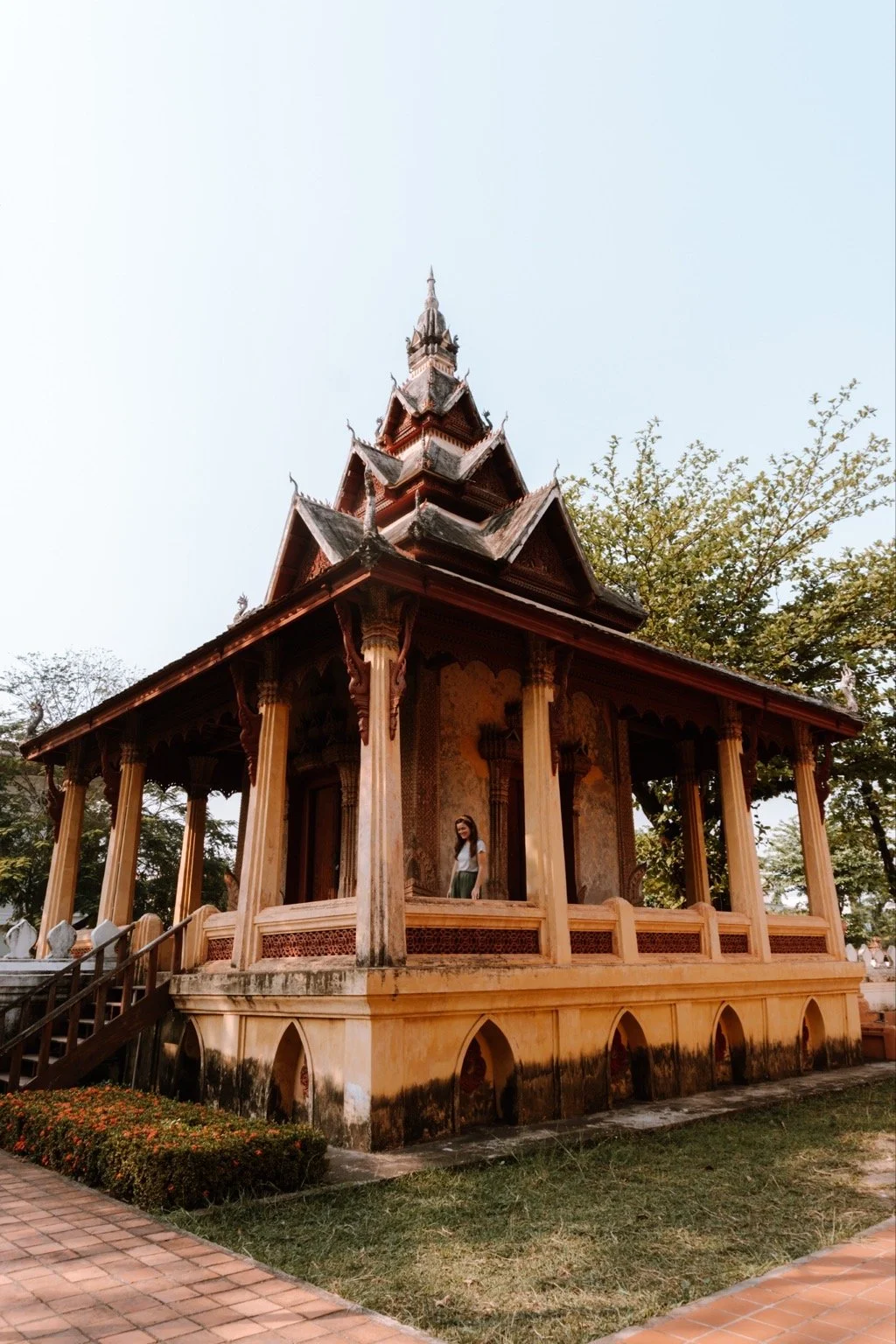a day of rice farming in Laos on Living Land Farm
Rice is a staple of the diet in Laos. Sticky or steamed, it accompanies almost every meal. Living Land Farm outside of Luang Prabang offers tourists an all-day rural rice farming experience so that visitors may understand the work that goes into planting, harvesting, and cooking this grain.
Knowing where your food comes from is more than just a hipster cafe trend. It leads to deeper cultural understandings and appreciation for the labour involved in producing the food on your plate. My time with Living Land left me thinking of all the things I consume that I don’t know the origin of, even as someone who tries hard to consume organic, plant-based foods. Things like the grains for my bread or the coffee in my cup, or the rice on my plate..
Let me back up and say, I never used to think about where the food on my plate came from. I went vegetarian a lifetime ago. I don’t actually remember my carnivorous life, if we’re honest. I do, however, remember being the one at dining events or housewarming parties that had to bring her own veggie burgers for the grill or avoided bringing attention to what I was ordering. At the start of my plant-based journey, none of it had anything to do with animal rights. I just didn’t like meat and I wanted to try something new.
As time passed, my vegetarian diet made me question my general lifestyle more and more. Sustainability trickled into everything. I found ethical brands I loved to wear {yas Everlane + Uncle, yasssss}. I minimized my plastic usage. I asked myself the questions you have to ask yourself when making more conscious choices {knowing that my privilege allows me to make such decisions}, and I continue to learn more and grow daily.
However, it wasn’t until I went to Living Land Farm that I understood the efforts that go in the staple of a Southeast Asian diet, and a food I absolutely love— sticky rice. Why had I never thought about the origin of the rice I eat before? Luckily, that’s changed now, and I can say I not only know where my rice comes from, but how much work it is to farm it.
WHAT IS “LIVING LAND FARM”
Living Land Farm is a working community enterprise that was founded in 2005 by a group of locals who decided to share their land, work together, and create an organic garden. Since 2005, it’s grown into a handicrafts center and a homestay. Tourists have the opportunity to learn about Lao agricultural heritage via a hands-on experience, where you are allowed to play farmer for the day using traditional rice farming techniques.
Living Land Farm holds free English language classes on their farm for children from local villages. They also allow their land to be used for training for students from the Northern College of Agriculture. As if that weren’t enough, the Living Land project supports children from low-income families with their education and medical needs. Despite the heavy stigma that Southeast Asia as a region has against physically handicapped people, Living Land farm employs those with disabilities.
I adore the sense of community at Living Land and how friendly every one of its employees was. The entire atmosphere of the farm was “happy”.
THE PROCESS OF RICE FARMING
Rice farming in Laos is a 14-step process. Yeah. It’s a ton of work and hard labour. On the Living Land Farm rice experience tour, you get to try your hand at all 14 steps, guided by a local farmer.
1. select the grain
As soon as one harvest is complete, farmers begin working the next crop. A tiny percentage of the rice grains are set aside and saved to be used as seeds for the next crop. The traditional way of sorting the grains that are set aside is to place them in a bowl of saltwater. The grains that sink are healthier, so they are the ones that get replanted. The salt is rinsed off the grains and those seeds that floated are feed to the farm’s livestock.
2. plant the seeds in the nursery
The seeds that sank in step #1 {the healthier seeds} are replanted in the nursery. The planting process is simple and only requires sprinkling the seeds in an empty paddy on top of the mud. The rice seeds sprout at an alarmingly fast rate! We saw seedlings that had only been in the nursery for five days that were longer than my thumbs.
3. plough the field
When the seedlings are deemed strong enough by the farmers, they prepare a paddy by ploughing the land with the help of a buffalo. At Living Land Farm, they still use a water buffalo to plough the land. I will admit, at first, I was hesitant. Rodolphe, their 8-year-old water buffalo, looked a bit bored and unimpressed standing in the mud waiting to work. However, I was quickly reminded that this is a traditional experience and a different way of life. I was also reminded that Western foreigners often treat animals with much less dignity. Yes, Rodolphe works hard at Living Land, but he’s well fed and cared for. No one was cruel to Rodolphe, and he wasn’t whipped or starving. He was a working farm animal and I was simply not used to seeing that firsthand.
4. transplant the seedlings
Next, farmers move the seedlings from the nursery to the ploughed field. Each seedling must be planted in the mud by hand. This can be an especially long process when the heat is excruciating. To pass the time, farmers sing songs and tell jokes.
5. water and weed the seedlings
Watering the fields happens naturally with the help of nearby waterfalls. Once the fields are wet enough, the farmers block the canals with mud to ensure they don’t flood.
6. harvest the crop
Farmers have to watch the rice crop with precision sharp eyes. If they leave the grains for too long, they fall into the wet paddy and are no longer usable. The harvest can’t be delayed, so farmers have to be in a constant state of “ready”. Once the rice is ready to be harvested, farmers cut the stalk near the base with a handmade sickle and bundle the rice stalks together. Bundles are placed in the sun to dry out.
7. thrash the bundles of rice
When the rice is dry, the bundles are thrashed against a wooden board. I gave thrashing the bundles a try, beating a bundle using a set of batons to release all the grains, then expertly tossing the stalks aside. It was basically the upper body workout of my life {that is, until I gave blacksmithing a try, more on that in an upcoming post}.
8. clean the straw from the grains
Thrashing the stalks get a lot of the rice out of the bundles…but it also sends straw and rice husks everywhere. Since these materials are lighter than the rice grains, farmers use a fan in a figure-eight motion to sort the rice from the rest. It almost looked like dancing to me.
9. pack and store the rice
Rice is loaded into baskets to be transported into homes or storage. The Hmong, Khmu, and Laos carry 30 kilograms of rice at a time in a different way. Carrying this much rice is incredibly hard work. Some women carrying these baskets have to walk with them for five hours or more to their villages.
10. husk the rice
Living Land Farm doesn’t use machines! They prefer to honour traditional methods of husking rice. Instead of modern agricultural technologies, they stomp on a long piece of timber that hammers the rice in a stone bowl. It’s a massive leg workout and I basically had to jump on the end of the timber, while a woman half my size powered it with her foot to a seriously natural rhythm.
11. separate the grains from the husks
Despite having already husked the grains once, farmers still have to sort the edible part of the rice from the husks themselves. The innovative women of Laos weave trays from bamboo to throw the rice into the air and catch it. The husks fly out and the edible grains land back in the tray. This takes a lot of practice, but, they say, once you nail it you are “ready to be married”. I nailed it. Just. Saying.
12. soak the rice
Before cooking sticky rice, you have to soak it overnight. Six hours is fine, but overnight is optimal for the right amount of “stick”.
13. cook the rice
Sticky rice is always steamed, never boiled, in bamboo baskets that sit on top of a pot of water being boiled by a fire. Rice is flipped, never stirred, by being tossed into the air and caught in the bamboo basket so that it’s cooked evenly.
14. feast
The average Lao local eats nearly 21 kilograms of sticky rice per month. It’s no surprise that at the end of the long process, farmers want nothing more than to reap what they have sewn. At the end of my tour, I not only got to replenish electrolytes with freshly squeezed sugar cane juice with lime, but I also got to try all kinds of sticky rice dishes— rice candy, rice cakes, sticky rice and jeow bong {winning}, and sticky rice louts flower cakes.
UNITED BY RICE
I am a firm believer in the idea that more connects us in this world than separates us. However, I also subscribe to the philosophy that our differences make us special, and don’t have to be divisive. Out of 49 ethnic minorities in Laos, there are three that you hear about most often: the Lao, the Hmong, and the Khmu. The Hmong, Khmu, and Lao people all have different ways of carrying rice that has been harvested to their homes and villages— some walking for nearly 6 hours.
The Khmu use a woven basket with a strap wrapped around their head {like pictured above}. My basket had a few large handfuls of rice in it, whereas a Khmu woman would carry between 20 and 30 kilograms. They might also be carrying their child in a wrap on the front of them.
The Hmong fashion a bamboo basket in a “backpack-like” fashion. While it seems like this would be easiest, I found the Khmu head-basket much, much more comfortable with less strain on my back. 30kgs on your back is a lot of weight {took me back to my South America days}.
Lao women carry their rice in two baskets, one on each end of a wooden plank {pictured below}. If they walk straight, the baskets will swing. This is why, if you see a Lao woman carrying rice, it almost looks like she’s dancing. She must walk in rhythm with the rice to avoid the baskets swaying constantly into her.
WHAT’S INCLUDED IN YOUR LIVING LAND TOUR
The rice farming experience with Living Land Farm includes pick up from your accommodation, a bamboo souvenir, complimentary beverages, a guided tour lasting 4-5 hours, rice snacks, sugar cane juice, and a certificate saying that you successfully planted rice in Laos. I walked away from the tour with a bamboo bracelet and ring, having devoured all the jeow bong and sticky rice I could get my hands on, my thirst fully quenched thanks to copious amounts of free coffee. I also left the farm with a profound understanding of the work it takes to get rice from farm to table. While you get to try selected rice snacks at the end of your tour, a full lunch is not included.
TIPS FOR YOUR TIME AT LIVING LAND
Bring your camera! The farm showcases the gorgeous natural beauty of the Lao countryside.
Wear sunscreen! Despite being given a traditional rice farming hats for the day, my arms and legs got a lot of sun.
Prepare to get dirty by wearing old clothes and shorts! One girl on our tour was wearing pants and I watched her tirelessly roll up each leg between bits of the tour, constantly having to stop and re-roll them. I felt for her, because nothing is worse than worrying about your clothes getting ruined while simultaneously trying to enjoy an excursion. The rice fields are muddy and, if you’re short like me, it’ll hit you way above the knee. During your complimentary tea and coffee break, you will get to use scrub brushes and water buckets to clean yourself off. Getting messy is part of the fun and Living Land Farm’s website suggests you wear shorts.


























































